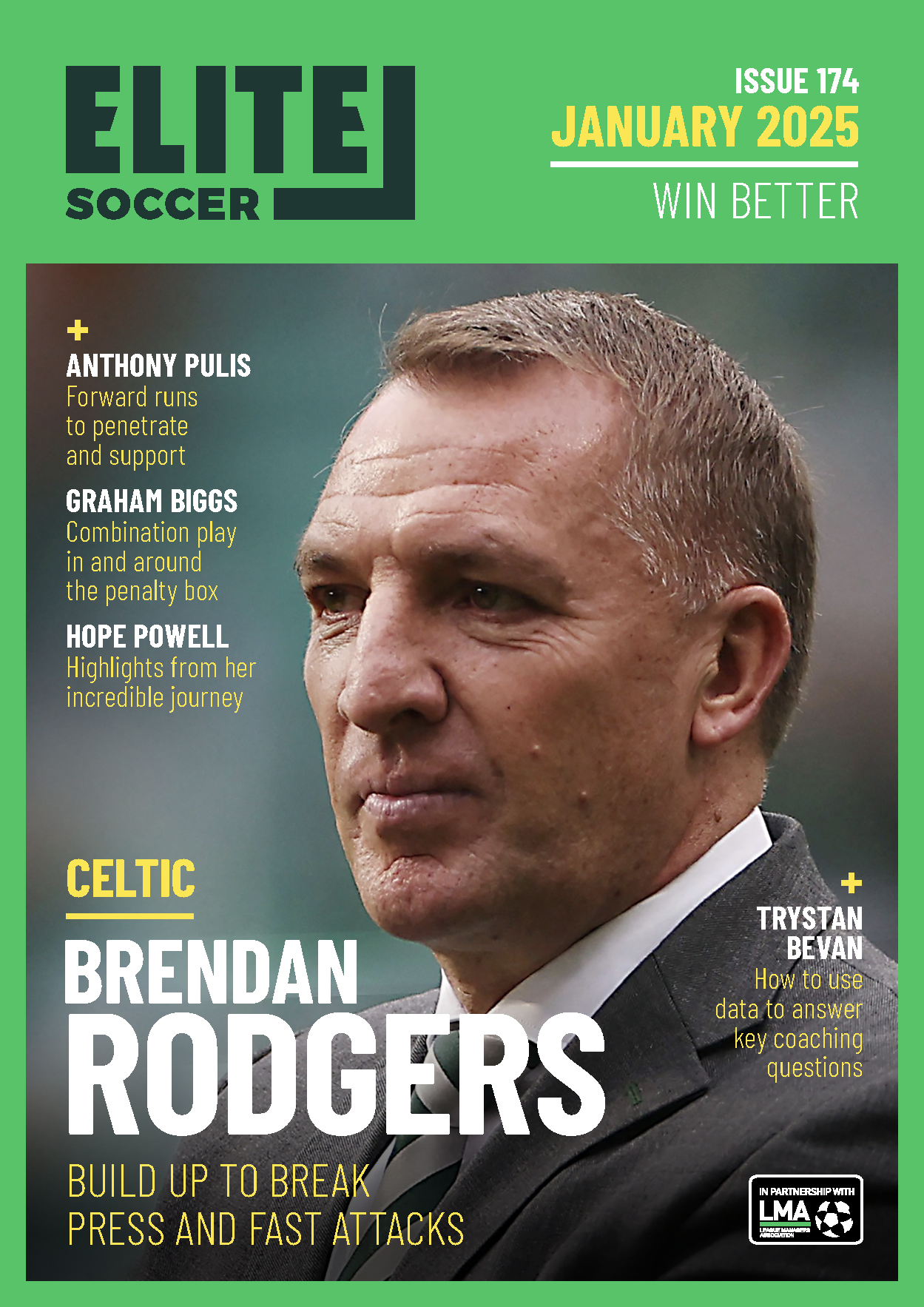You are viewing 1 of your 1 free articles
Defensive organisation
The idea with this session is to press high up the pitch to win the ball – this means that the defence must move up quickly to cover any spaces to keep the team compact and not leave space for the opposition to play into.
| Area | Up to two thirds of pitch |
| Equipment | Balls, bibs, cones, poles |
| No. of Players | 20 players + 2 goalkeepers |
| Session Time | Warm-up [not shown]: 10mins, Possession activity: 6mins, Defending centrally: 12mins, The defensive line: 12mins |
The idea is to press high up the pitch to win the ball – this means that the defence must move up quickly to cover any spaces to keep the team compact and not leave space for the opposition to play into.
We start the session in a tight square where the defensive players must block, intercept and tackle to get the ball back and stop play getting to the wide players – defenders must cover spaces left by the possession team.
The session is then opened out so a central square becomes the vital area where the defence must block moves through the midfield to stop the possession team earning points.
In the final activity, now that the area has been opened up around the square the defending team must cover any moves by the opposition, or the attacking team will be able to play into space behind the pressing defenders.
The idea is that with a high defensive line, teams can block passes through the middle gates situated on the halfway line.
Since our first defensive idea is to press high up the pitch to regain the ball, we need to ensure that our defenders are closing the space behind our press and ensuring the team is compact. This helps pressing because the opponent can find no space to play and they have to play the long ball.
In addition, in the moments you are spread out and can’t squeeze high up the pitch as a compact unit, you can drop deeper and then block the middle gates using your front players. So you are now using a deeper defensive line but still blocking the middle of the pitch, which is a strategically valuable area.
We would run a session like this on average once a month.
What do I get the players to do?
Possession activity
After a warm-up [not shown], we set up an area of 22x22 yards. We’re using 11 players split into two teams of four, and three neutrals who play for the team in possession.
Both of the teams are in the centre of the area – one neutral joins them and the other two are stationed on opposite sides of the box.
The coach starts play by passing into the area. To score points, the team receiving the ball must string 10 consecutive passes together, as shown [1], while the other team must try to turn over possession. If they win the ball, they become the passing team.
Play is two-touch and the ball must be played along the floor, with no passes made over waist height. Play for 3 minutes.
1

2. To score, the possession team must make 10 passes using the help of the three yellow neutrals
3. Players are two-touch and must pass on the floor
How do I progress the session?
Using exactly the same set-up, we progress the activity by changing the way that players score points. In this variation of the activity, the team in possession scores points by transporting the ball from the neutral player at one end of the area to the neutral player at the other end, as shown [2]. Play is still two-touch and the ball must be played along the floor. Play for 3 minutes.
2

2. This time the possession team can score by getting the ball from one neutral end player to the other
What are the key things to look out for?
We look for players to be giving options to their team mates and to be creating good open lines for passing. We also want to see players making good use of space and occupying the area well.
What do I get the players to do next?
Defending centrally
We set up an area of 60x52 yards with a 24-yard box marked out centrally. We are using 20 players split into two teams of 10, plus two neutral goalkeepers, one positioned at each end.
This is a 10v10 directional game and plays starts with a pass from one of the goalkeepers to a defender. The aim is for the attacking team to work the ball from one end to the other and they score a point if they are able to pass to the keeper at the end they are attacking, as shown [3]. An extra point can be scored if players work the ball through the central box, passing it across the halfway line from one side of the box to the other.
3

2. Teams can score by working the ball through the central box, passing it across the halfway line from one side of the box to the other
3. The defending team must try to block movement through the central areas in the box
4. Teams can also score if they play a forward pass to the keeper at the end they are attacking
The aim for the defending team is to attempt to block movement through the central box and prevent the attacking team from playing a scoring pass to the keeper. If they gain possession, they should try to work the ball to the end they are attacking.
Play two games of 6 minutes.
The defensive line
For this tactical game we set up between the penalty boxes with 5-yard pole gates positioned on either side of the pitch (level with the 18-yard line) and with two central gates on the halfway line, as shown [4]. We play a 10v10 plus 2 goalkeepers. The keepers begin between the wide gates.
4

2. Teams can score a point by passing forward through the middle gate
3. Teams can also score by dribbling through the end gates. Look for 1v1 duels as defenders try to stop attackers
4. Goalkeepers can also try to block attacks
The coach starts play with a pass out to one of the teams in their own defensive half – to score a point, players must pass forward through one of the middle gates or dribble through one of the end gates. The goalkeeper at each end should move to try to block attacks through the gates on either side.
Players are three-touch except for wide players, who are all in. Play two games of 6 minutes.
What are the key things to look out for?
We look for the defensive line to squeeze up and block passing routes through the middle of the area. We also want to see the defending team setting and exploiting pressing traps in the wide areas.
Attacking players should make runs in behind to receive the ball and we would hope to see confident 1v1 battles out wide, as defenders try to stop the attackers from dribbling through the wide end gates to score a point.
Related Files
Editor's Picks
Using the goalkeeper in build-up play
Pressing principles
Intensive boxes drill with goals
Penetrating the final third
Creating and finishing
My philosophy
Pressing initiation
Compact team movement
Defensive organisation
Coaches' Testimonials

Alan Pardew

Arsène Wenger

Brendan Rodgers

Carlos Carvalhal

José Mourinho

Jürgen Klopp

Pep Guardiola

Roy Hodgson

Sir Alex Ferguson

Steven Gerrard
Coaches' Testimonials

Gerald Kearney, Downtown Las Vegas Soccer Club

Paul Butler, Florida, USA

Rick Shields, Springboro, USA

Tony Green, Pierrefonds Titans, Quebec, Canada
Join the world's leading coaches and managers and discover for yourself one of the best kept secrets in coaching. No other training tool on the planet is written or read by the calibre of names you’ll find in Elite Soccer.
In a recent survey 92% of subscribers said Elite Soccer makes them more confident, 89% said it makes them a more effective coach and 91% said it makes them more inspired.
Get Monthly Inspiration
All the latest techniques and approaches
Since 2010 Elite Soccer has given subscribers exclusive insight into the training ground practices of the world’s best coaches. Published in partnership with the League Managers Association we have unparalleled access to the leading lights in the English leagues, as well as a host of international managers.
Elite Soccer exclusively features sessions written by the coaches themselves. There are no observed sessions and no sessions “in the style of”, just first-hand advice delivered direct to you from the coach.









